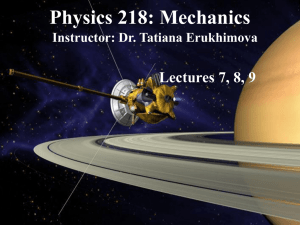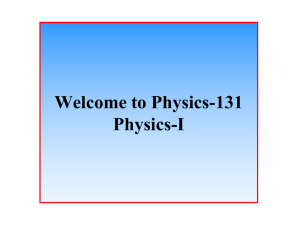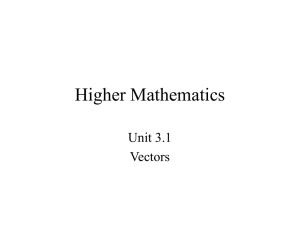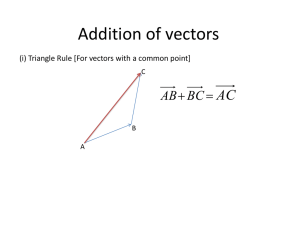Study Advice Services
advertisement
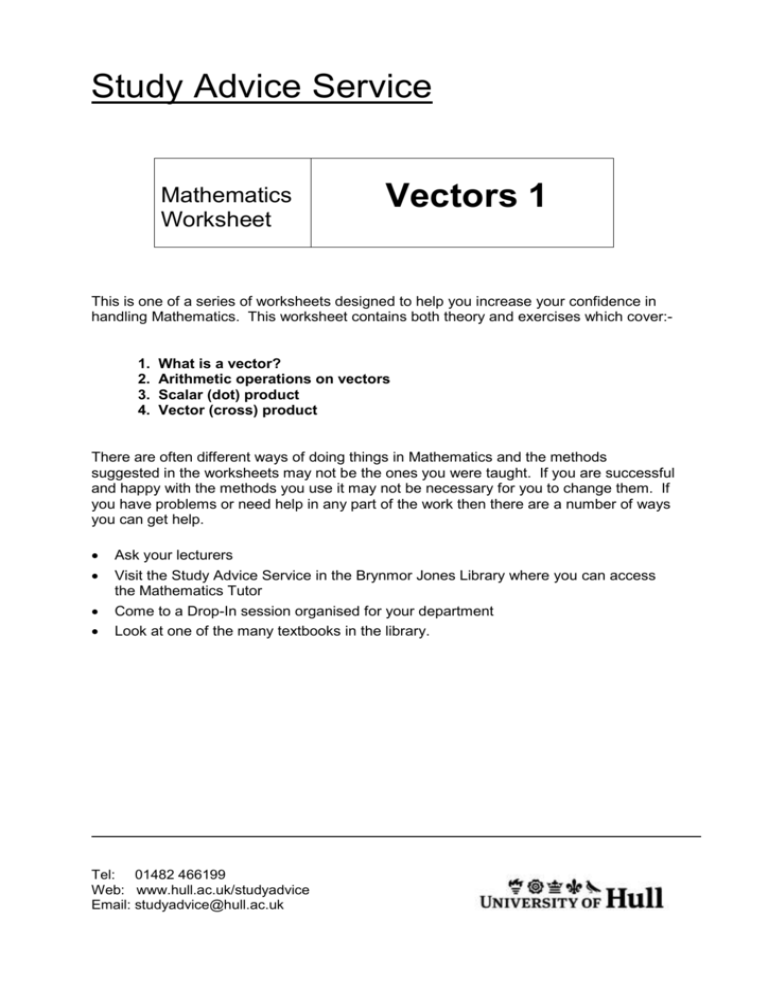
Study Advice Service Mathematics Worksheet Vectors 1 This is one of a series of worksheets designed to help you increase your confidence in handling Mathematics. This worksheet contains both theory and exercises which cover:- 1. 2. 3. 4. What is a vector? Arithmetic operations on vectors Scalar (dot) product Vector (cross) product There are often different ways of doing things in Mathematics and the methods suggested in the worksheets may not be the ones you were taught. If you are successful and happy with the methods you use it may not be necessary for you to change them. If you have problems or need help in any part of the work then there are a number of ways you can get help. Ask your lecturers Visit the Study Advice Service in the Brynmor Jones Library where you can access the Mathematics Tutor Come to a Drop-In session organised for your department Look at one of the many textbooks in the library. Tel: 01482 466199 Web: www.hull.ac.uk/studyadvice Email: studyadvice@hull.ac.uk 1. What is a vector? The definition of a vector is ‘a directed line segment’. This means that a vector is part of a line, and has a direction attached to it. a c b Examples of vectors A vector can be described in two ways. The first is component form which measures how far the vector reaches in each direction. The second way is by means of a magnitude and a direction. The magnitude is the length of the line segment and the direction is the direction in which the vector is headed, denoted by an arrow. Vectors are represented in different ways. They may be typed in bold such as a, or as a letter with a line or arrow above or below it, such as a , a or a . The underline notation will be used here, but it is best to stick to the notation that your department or lecturer uses. The notation â (known as ‘hat’) is used for unit vectors. These are a special type of vector whose length is 1 unit. If a vector starts at point A and ends at point B it is written as AB . Similarly a vector from B to A is BA and from the origin to A is OA . These are referred to as position vectors. Two vectors are equal if and only if their lengths and directions are the same. A vector the same length as a but going in the opposite direction is written as –a. The vector which has no magnitude and no direction is known as the zero vector and is denoted 0. Vectors and scalars Vectors are often compared with scalars. Scalars are numerical values. These have a magnitude, but not a direction. Vectors and scalars are used in mechanics and physics. Speed measures how fast an object is travelling. It is a scalar quantity. Velocity measures how fast an object is travelling and in which direction. It is a vector quantity. For example if a car travels at 50mph in an easterly direction, its speed is 50mph, and its velocity is 50mph east. 1 Distance travelled is a measure of the total distance covered. This is a scalar quantity. Displacement is a measure of where the object is compared with where it was at the start. This is a vector quantity. For example if an athlete runs twice around a 400m track, the distance travelled is 800m, but as they are back where they started from, their displacement is 0. Numerical representation of vectors As stated before there are two types of representation, component form or magnitude and direction. When writing a vector in component form, the positive directions are right and up. 5 2 a This vector is written as a or a 5,2 . The first representation is called a column vector, as the entries are laid out in a column, horizontal at the top. The horizontal value is always the first value. Magnitude and direction form Magnitude and direction form is used a lot to show the resultant forces acting on objects. For example, you may find a projectiles question starting with ‘a projectile is released with an initial force of 25 Newtons at an angle of 40 degrees…’ To convert between the two forms we use Pythagoras’ Theorem and trigonometry. Example – From component to magnitude/direction 2 4 Given b , draw the triangle 4 2 The magnitude of the vector is the hypotenuse of the triangle. 2 2 2 Using Pythagoras’ Theorem ( a b c ) we find that: 22 42 c 2 4 16 c 2 20 c 2 c 20 =4.47 to 2 decimal places To find the angle we use the tangent function on the components. tan 2 opposite adjacent 4 2 To solve for take inverse tangents of both sides, giving 2 tan1 (2) 63.43 to 2 d.p. 2 So the vector b is equivalent to a line of length 4.47 at an angle of 63.43 . 4 tan Example – From magnitude/direction to component form Given a magnitude of 13 and an angle of 35 . Sketch the line as the hypotenuse of a right-angled triangle. To find the horizontal component we need to use cosine. Calling the 13 y 35 horizontal component x , we have cos 35 x adjacent x hypotenuse 13 Rearranging this gives 13 cos 35 x which can be worked out on your calculator to give x 10.65 to 2 d.p. To find the vertical component we need to use sine. Calling the vertical component opposite y . hypotenuse 13 Rearranging this gives 13 sin 35 y , and working this out on a calculator gives y 7.46 to 2 d.p. 10.65 Hence the component form of this vector is . 7.46 y gives sin 35 Note 1: If one or more component is negative, then the angle will be more than 90 . It is always best to draw a diagram in order to ensure that you are looking for the correct angle. Note 2: For angles larger than 180 you can either write them as larger than 180 or write them as a smaller negative value. For example 325 35 Exercise 1 Q1 Write out the following vectors in component form: ii) iv) iii) i) Q2 Convert the following vectors into magnitude and direction: (round answers to 2 decimal places) 3 a 1 2 b 6 2 c 5 3 d 2 3 Q3 Convert the following vectors into component form: (round answers to 2 d.p.) i) Magnitude 10, angle 25 ii) Magnitude 15, angle 75 iii) Magnitude 12, angle 195 2. Arithmetic operations on vectors When performing arithmetical operations on vectors it is simpler to have them in component form than in magnitude and direction form. One important concept to understand is that if you move a vector without altering the magnitude or direction the vector remains the same. This means that we can translate vectors in order to make calculations easier. For example, in the following diagram, although the vectors start and finish in 2 1 different places, they are all the vector . Addition of vectors To add one vector to another, you add the horizontal components together and the vertical components together. Graphically this is the same as drawing the first vector and then moving the second one so that it starts where the first one ends. 1 3 3 2 4 5 For example: From the diagram, you can see that this is equivalent to the vector which starts at the tail of the first vector and ends at the tip of the second. The direction of this vector is always from the first vector to the last. The addition of vectors obeys the commutative and associative laws. Subtraction of vectors The numerical subtraction of vectors is similar to the numerical addition of vectors except that you are subtracting rather than adding. 4 Example - vector subtraction 1 3 3 2 2 . 1 Numerically, The standard way of representing this in a diagram is to draw the two vectors as a parallelogram, where each vector appears twice. The vector which represents the subtraction of the two vectors is the vector which forms one of the diagonals of this parallelogram. (Note that the other diagonal is the result of adding the two vectors). Another way of thinking about this is to draw the second vector starting from the nose of the first, but to draw it going in the opposite direction. You can see from the diagram that this has produced a vector in a different place on the diagram, but by comparing it with the diagram above, you can see that this is still the same vector. Remember to take care with the direction of the resulting vector. You should be able to produce one of the original vectors by adding the result to the other original vector. In terms of position vectors; if you are given a, the vector from O (the origin) to A ( OA ) and b, the vector from O to B ( OB ) and need to find the vector from A to B ( AB ), then AB OB OA b a Multiplication of a vector by a scalar Multiplying a vector by a scalar has the effect of multiplying both the horizontal and the vertical component by that value. For example: 1 3 3 This is the equivalent of taking 3 copies of 2 6 1 2 and placing them end to end. In magnitude/direction form this is equivalent to multiplying the magnitude by the scalar. If the scalar is negative then the angle is rotated by 180 . The multiplication of a vector by a scalar obeys the distributive and associative laws. Exercise 2 Q1 Add the following pairs of vectors: 2 3 5 7 i) 8 2 1 4 ii) 6 4 1 3 iii) 5 Q2 Perform the subtractions 5 2 4 3 10 6 9 3 8 2 5 3 i) ii) iii) Q3 Multiply each vector by the given scalar 5 2 3 8 ii) , 2 i) , 4 2 , 3 13 iii) 3. Scalar (dot) product The most common use for the scalar product is to find the angle between two vectors. In particular, it is used to find out if two vectors are at right-angles to each other. If two vectors are at right-angles to each other then they are called perpendicular or orthogonal. It is also used to find the orthogonal projection of one vector onto the direction of another. This is best shown with a diagram: a b The projection of vector a onto vector b is the part of b shown between the arrows. You can see that if the angle between a and b were 90 that the projection would be =0. In order to work out the scalar product, you need to be familiar with the concept of the modulus. The modulus of a vector is another name for its magnitude. In other words it is the length of the vector. The modulus can be found by using Pythagoras’ Theorem on the horizontal and vertical components as described earlier. However we are not restricted to finding the modulus for vectors in 2 dimensions. The modulus of a vector in 3 dimensions is found in the same way. Example If a (4, 2), If b (4, 2, 3), a 42 22 20 . b 42 22 32 29 The formula for the scalar product is: a b a b cos where is the angle between the vectors 6 a b is used as shorthand for n ai bi . i 1 This means take the first element of each vector and multiply them together. Then take the second element of each vector and multiply them together. Once you’ve run out of elements to multiply, add up the results. Examples 1. Given a (3, 4), b (1, 2) find a b . a b 3 1 4 2 3 8 11 (In physical terms this means that if a were to be projected onto the line containing b , then the resulting line would be 11 units long.) 2. Given a (2, 3,1), b (1, 2, 4) find a b . Comment on your result. a b 2 1 3 2 1 4 2 6 4 0 As a b 0 , this means that the vectors are perpendicular to each other. Using the scalar product to find the angle between 2 vectors In order to find the angle between 2 vectors we need to use both sides of the scalar product formula: a b a b cos The simplest way to use this formula is to work out the values of a b , a and b first. Example Find the angle between a (5, 2) and b (2, 3) . a b 5 2 2 3 10 6 4 a 52 22 29 , b 22 (32 ) 13 Substituting these values into the formula gives: 4 29 13 cos Rearrange to get 4 29 13 cos Evaluate the LHS 0.0206010481 cos Using the inverse cos function gives 78.11134196 7 The angle between a and b is approximately 78.11 degrees. Exercise 3 Q1 Find the value of a b for the following pairs of vectors: a) a (2,5), b ( 4, 6) b) a (1, 2, 4), b (2, 9, 3) c) a (3, 2, 7), b (1, 4, 9) Q2 Use the scalar product to find the angle between the vectors, rounding your answers to 2d.p. a) a (6, 2), b (2, 3) b) a (1, 4), b (8, 3) c) a (3, 2, 4), b (1, 6, 3) 4. Vector (cross) product The vector or cross product is another method for multiplying vectors. Given vectors a and b it is used to find a vector c which is perpendicular to both vectors. It is used with 3-dimensional vectors. One way to express the cross product is: ˆj kˆ a b a1 a2 b1 b2 a3 b3 iˆ This requires a little explanation. First of all, iˆ, ˆj, kˆ are the basis vectors for 3-dimensional space, that is they are three vectors which can be combined to produce all possible vectors in 3dimensional space. iˆ (1,0,0) i.e. 1 in the x direction; ˆj (0,1,0) , i.e. 1 in the y direction; kˆ (0, 0,1) i.e. 1 in the z direction. The between product. a and b is not a multiplication sign, it is a cross to denote cross The ai and bi represent the i The modulus symbol th component of vectors a and b . means we need to find the determinant. 8 The calculation that is performed in order to find the cross product is this: iˆ ˆj a b a1 a2 b1 b2 kˆ a3 (a2b3 a3b2 ) iˆ (a1b3 a3b1 ) ˆj (a1b2 a2b1 )kˆ b3 Note that the symbol in front of the ĵ bracket is -. This will always be the case. In essence what you are doing is this: 1. Cover up the row and column which contain iˆ . This will leave 4 numbers visible. 2. Multiply the number in the top left by the number in the bottom right. 3. Multiply the number in the bottom left by the number in the top right and subtract this from the value you found in 2. 4. Repeat for the ĵ and kˆ rows and columns, taking care to include the minus sign for the ĵ term. 5. These values provide the coordinates for the new vector. Example Find a vector perpendicular to both a (2, 6,5) and b (2, 1, 4) . First write out the determinant, then work out the individual components by covering rows and columns as described above. iˆ ˆj kˆ a b 2 6 5 (6 4) (1 5) iˆ (2 4) (2 5) ˆj (2 1) (2 6) kˆ 2 1 4 The next step is to simplify each bracket. (6 4) (1 5) iˆ (24 5) iˆ 29 iˆ (2 4) (2 5) ˆj (8 10) ˆj (2) ˆj 2 ˆj (2 1) (2 6) kˆ (2 12)kˆ 14kˆ Putting this together gives 29 iˆ 2 ˆj 14kˆ (29, 2, 14) . The vector (29, 2, 14) is perpendicular to a (2, 6,5) and b (2, 1, 4) . In order to check the result, you can perform the dot product between each of the original vectors and the new vector, the result of both calculations should be 0. Exercise 4 Q1 Find a vector perpendicular to each of the following pairs of vectors: a) a (1, 4, 2), b (3, 2, 7) b) a (4,1, 3), b (2, 6, 4) 9 c) a (2, 3,1), b (5, 2,8) 10 Answers to Exercises Exercise 1 4 1 Q1 i) 2 ii) 3 2 iii) 1 3 iv) 3 Q2 a magnitude= 10 3.16 angle= 18.43 b magnitude= 40 6.32 angle= 71.57 c magnitude= 29 5.39 angle= 111.80 d magnitude= 13 3.61 angle= 326.31 33.69 9.06 3.88 11.59 ii) iii) 14.49 3.11 4.23 Q3 i) Exercise 2 5 12 ii) 3 1 ii) 20 8 ii) Q1 i) Q2 i) Q3 i) 2 4 10 3 iii) 6 8 iii) 6 16 iii) 16 6 6 39 Exercise 3 Q1 a) 22 b) -4 c) 68 Q2 a) 74.74 b) 55.41 c) 85.29 Exercise 4 Q1 a) (24, 1, 10) b) (14, 22, 26) c) (22, 21, 19) The information in this leaflet can be made available in an alternative format on request. Telephone 01482 466199 © 2009 11



